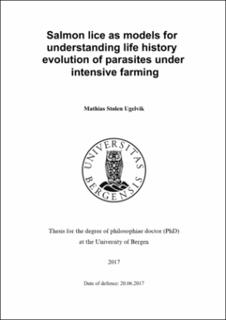| dc.contributor.author | Uglevik, Mathias Stølen | |
| dc.date.accessioned | 2024-02-27T12:51:28Z | |
| dc.date.available | 2024-02-27T12:51:28Z | |
| dc.date.issued | 2017-06-20 | |
| dc.identifier.isbn | 978-82-308-3035-2 | |
| dc.identifier.uri | https://hdl.handle.net/11250/3120109 | |
| dc.description.abstract | Human activities are drastically changing ecological conditions for living organisms and this leads to evolutionary changes. One example is the appearance and spread of resistance against drugs and antibiotics, but we also have evidence that new environmental conditions select for changes in how living organisms allocate resources between growth, reproduction and longevity. In parasites, such changes in life history traits could have several consequences, since life history traits are often closely connected to transmission rates, epidemiology and virulence.
Intensive farming of Atlantic salmon (Salmo salar) represents one such case of a severe change in ecological conditions, both to salmon and its parasites. This industry has increased rapidly during the last decades, and has caused an increase in the abundance of salmon lice (Lepeophtheirus salmonis). Salmon farms represent new ecological conditions for salmon lice, with year-round presence of a high number of susceptible hosts and reduced life expectancy due regular exposure to anti-parasitic drugs and slaughtering of hosts. From life history theory, we predicted that conditions in farms should select for higher investment into early reproduction, because future prospects of survival and reproduction are reduced. An increase in early reproductive investment could be manifested in several ways, for example by faster development, higher fecundity or by investing more into each offspring. If an organism increases its investment in reproduction it will need more resources and, for parasites, these resources must be taken from the host. We therefore predicted that an increase in early reproduction would also be associated with more virulent parasites.
The rapid increase of salmon farming in the last decades makes this a good modelsystem to test how human activities might affect life history and virulence of parasites. In this study we compared in the laboratory the life history traits and virulence of salmon lice sampled from locations with salmon farms (Frøya and Bergen) to those of lice sampled from locations without farms (Oslo and Eastern Scotland).
Salmon lice life history traits suggest that they are adapted to low and unpredictable host availability. Under natural conditions the sexually reproducing louse may therefore be selected to increase aggregation (Paper I) in order to maximize the chance of finding a mating partner. In accordance with this, we found that individual fish already infected with lice were more susceptible to new infections (Paper I). However, in salmon farms the number and density of susceptible hosts is much higher, which has increased lice intensities. Under such conditions aggregation could result in too high parasite loads. High loads of salmon lice on infected fish results in a reduction in lice fecundity, probably caused by increased resource competition on the host (Paper II). There was no effect of parasite load on lice survival (Paper II).
We found differences in life history traits between lice from locations with farms (Frøya and Bergen) compared to lice from locations without farms (Eastern Scotland and Oslo), suggesting that conditions in farms select for higher investment into early reproduction (Paper III). In our study lice from farms had lower overall fecundity and survival after infection, but higher fecundity at the first reproductive event (Paper III). Lice from farms also had lower adult survival, but their offspring had higher infection success, suggesting that lice in farms invest more in offspring quality (Paper III). Variation in these life history traits is likely caused by ecological conditions in salmon farms selecting for accelerated life history strategies, at the cost of a reduction in future survival and reproduction (Paper III). Lastly, lice from locations with farms caused more harm to their hosts. We suggest that this could be caused by conditions in farms such as reduced lifespan of hosts, the use of drugs to reduce lice abundances and the high density of susceptible hosts available (Paper IV). | en_US |
| dc.language.iso | eng | en_US |
| dc.publisher | The University of Bergen | en_US |
| dc.relation.haspart | Paper I: Mathias Stølen Ugelvik, Thor Mo, Adele Mennerat and Arne Skorping (2017). Atlantic salmon infected with salmon lice are more susceptible to new lice infections. Journal of Fish Diseases 40: 311-317. The article is available in the thesis. The article is also available at: <a href="https://doi.org/10.1111/jfd.12514" target="blank">https://doi.org/10.1111/jfd.12514</a>. | en_US |
| dc.relation.haspart | Paper II: Mathias Stølen Ugelvik, Arne Skorping and Adele Mennerat (2017). Parasite fecundity decreases with increasing parasite load in the salmon louse Lepeophtheirus salmonis infecting Atlantic salmon Salmo salar. Journal of Fish Diseases 40: 671-678. The article is available in the thesis. The article is also available at: <a href="https://doi.org/10.1111/jfd.12547" target="blank">https://doi.org/10.1111/jfd.12547</a>. | en_US |
| dc.relation.haspart | Paper III: Adele Mennerat, Mathias Stølen Ugelvik, Camilla H. Jensen and Arne Skorping (2017). Invest more and die faster: the life history of a parasite on intensive farms. Evolutionary Applications 10(9): 890-896. The article is available at: <a href="https://hdl.handle.net/1956/18053" target="blank">https://hdl.handle.net/1956/18053</a>. | en_US |
| dc.relation.haspart | Paper IV: Mathias Stølen Ugelvik, Arne Skorping, Olav Moberg and Adele Mennerat (2017). Evolution of virulence under intensive farming: Salmon lice increase skin lesions and reduce host growth in salmon farms. Journal of Evolutionary Biology 30(6): 1136-1142. The article is available in the thesis. The article is also available at: <a href="https://doi.org/10.1111/jeb.13082" target="blank">https://doi.org/10.1111/jeb.13082</a>. | en_US |
| dc.title | Salmon lice as models for understanding life history evolution of parasites under intensive farming | en_US |
| dc.type | Doctoral thesis | en_US |
| dc.rights.holder | Copyright the Author. All rights reserved | en_US |
